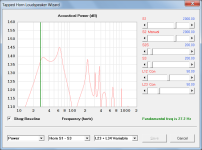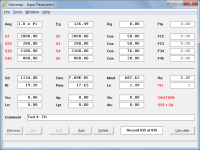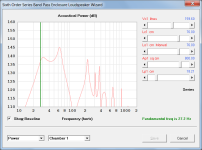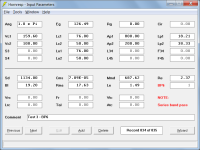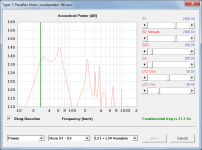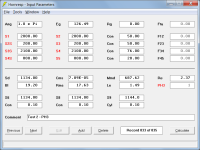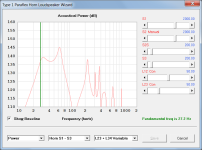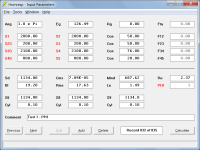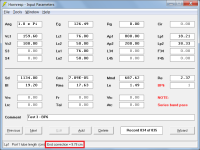Ok so I made BP6, TH and PH3 as close as I could without decimals.
BP6:


PH3:


TH with a rear chamber as the stub and throat adapter and port as the rear chamber:


So TH and PH3 look pretty similar and both have a tuning around 26/58, but BP6 still has a lower tune of about 24/51Hz, and all of them are 316l +-0.5l.
So it must be the stub between the cone and front chamber that raises the tuning because it is simulated in both TH and PH3, but not BP6.
BP6:
PH3:
TH with a rear chamber as the stub and throat adapter and port as the rear chamber:
So TH and PH3 look pretty similar and both have a tuning around 26/58, but BP6 still has a lower tune of about 24/51Hz, and all of them are 316l +-0.5l.
So it must be the stub between the cone and front chamber that raises the tuning because it is simulated in both TH and PH3, but not BP6.
I found a graphical bug in at least the PH and TH models.
Thanks for mentioning this. It will be fixed in the next update.
So TH and PH3 look pretty similar and both have a tuning around 26/58, but BP6 still has a lower tune of about 24/51Hz, and all of them are 316l +-0.5l.
The attached PH1, PH3, BP6S and TH designs all have the same 27.2 Hz fundamental frequency. I will leave it to you to work out why
(The port tube lengths in the BP6S design have been shortened to take into account the automatically-added end corrections).
Attachments
E.g. with a PH1 model, why does it say this is s5, s6 and s7
It is not saying S5, S6 and S7 (cross-sectional areas), it is saying Segment 5, Segment 6 and Segment 7.
Segments 5, 6 and 7 are shown as H5, H6 and H7 on the system model diagram:
The attached PH1, PH3, BP6S and TH designs all have the same 27.2 Hz fundamental frequency. I will leave it to you to work out why.
(The port tube lengths in the BP6S design have been shortened to take into account the automatically-added end corrections).
I'm on my phone, do the 4 enclosures have the same total volume with the shorten port tubes?
Ok thanks.(The port tube lengths in the BP6S design have been shortened to take into account the automatically-added end corrections).
So this is at least a meaningful difference. What sort of end corrections are being applied and how would they look like IRL?
Are there no end corrections in the horn models or?
The horns had the same total volumes and the BP6s had about 10l less, because the ports were shorter to account for end correction, which is not accounted for in the total volume, I presume.I'm on my phone, do the 4 enclosures have the same total volume with the shorten port tubes?
I see, I've been playing around with a bunch of things and done some misclicks, but it shouldn't matter as the sections are straight.In post #14,617, PAR segments were used for the PH1 model and CON segments were used for the PH3 model.
do the 4 enclosures have the same total volume with the shorten port tubes?
System volumes are:
PH1 = 292.339 litres
PH3 = 292.339 litres
BP6S = 281.834 litres
TH = 292.000 litres
Using the TH (H1 + H2 + H3 + H4) volume as the baseline reference:
PH1 = TH + H5 + H6 + H7
PH3 = TH + H5 + H6 + H7
BP6S = TH - Ap1 x Lp1EC - Ap2 x Lp2EC
TH = TH
Where:
TH = 292 litres
H5 = Sd (1134 cm^2) x 0.10 cm = 0.113 litres
H6 = Sd (1134 cm^2) x 0.10 cm = 0.113 litres
H7 = Sd (1134 cm^2) x 0.10 cm = 0.113 litres
Ap1 = 800 cm^2
Lp1EC (end correction) = 9.79 cm
Ap2 = 200 cm^2
Lp2EC (end correction) = 11.67 cm
Therefore:
PH1 = 292 + 0.113 + 0.113 + 0.113 = 292.339 litres
PH3 = 292 + 0.113 + 0.113 + 0.113 = 292.339 litres
BP6S = 292 - (800 x 9.79) / 1000 - (200 x 11.67) / 1000
BP6S = 292 - 7.832 - 2.334 = 281.834 litres
TH = 292.000 litres
In post #14,617, PAR segments were used for the PH1 model and CON segments were used for the PH3 model.
You physically build a PAR enclosure even though the models have ZERO FLARE segments.
Because cylindrical elements are being used in the simulations it doesn't matter what flare types are specified for the segments.
If the built loudspeaker does not have cylindrical segments then the predictions may not be particularly accurate.
What sort of end corrections are being applied and how would they look like IRL?
Moving the mouse pointer over the BP6S loudspeaker Lp1 or Lp2 input field shows the applicable port tube end correction length in the status bar panel at the bottom of the window. Google 'end corrections' if you want to know more.
Are there no end corrections in the horn models or?
Hornresp assumes that segments are used for horn elements, not for port tube acoustic masses that require end corrections.
End corrections are only applied when port tube elements are used specifically.
Attachments
- Home
- Loudspeakers
- Subwoofers
- Hornresp
